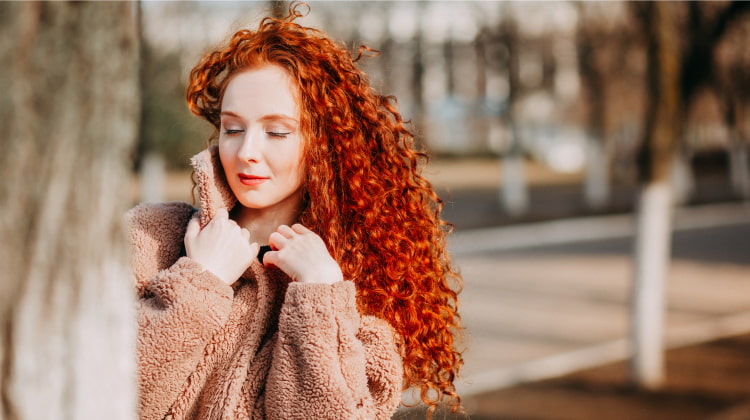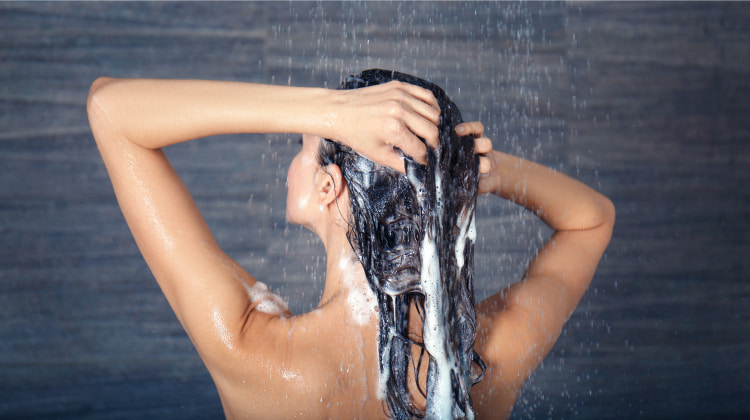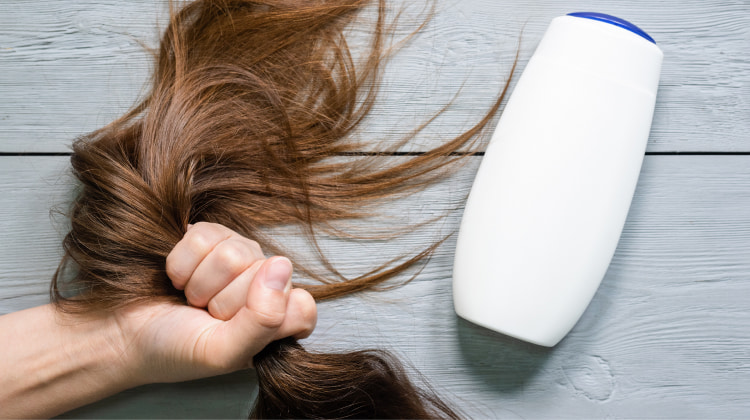.jpg)
When looking at your hair in the mirror, you might notice a reddish tint that wasn't there before and wonder "Why is my hair turning red". A sudden change in hair color can be alarming, especially when there doesn't seem to be a clear reason.
As our hair plays a significant role in our overall appearance, it's essential to track down the whys of this situation as fast as possible. This article will explore potential reasons why your hair is turning red and provide some tips to avoid or revert it.
7 Reasons Why Your Hair Turning Red & Solutions
Several factors can affect the color of your hair. These range from completely natural reasons to lifestyles and unexpected external catalysts.
Have Been Out in The Sun

Daily exposure to sunlight is the most common reason behind the question “Why is my black hair turning red?”. This is because dark hair colors like black or brown contain a red base, which becomes more noticeable when you spend too much time in the sun.
This happens because the sun breaks down the melanin(1) in your hair, causing it to gradually lighten and take on red tones. If you spend too much time in the sun, you might notice red streaks or a reddish tint in your dark hair.
Solution
Be mindful of the amount of time you're spending in the sun, as it can be damaging to your hair. If avoiding sun exposure isn't possible, you might consider tying your hair up and wearing a cap or scarf to provide some protection.
In addition, if you notice any unwanted red tones in your hair, using a toning shampoo could help to address that.
Genetic or Hormones

If you’ve observed that “my hair is turning red with age”, this is likely why. Genes can turn on and off at any time during a person's lifetime, so hair color can certainly change over time. The pigment-producing gene is also the gene that changes hair color, it is known as melanin(2). Moreover, the color of your skin changes because of this pigment.
However, let's get back to the question of what causes the hair pigment genes to turn on and off. Hormonal changes and having redheads in your family tree are both factors. You might notice that your hair is gradually turning red as a result.
Solution
You cannot stop the red color if it results from hormones or genes. All you can do is embrace it as your new natural hair color. However, if you believe that red doesn't suit your skin tone, you can always dye your hair.
Poor Diet and Improper Lifestyle

Malnutrition can cause changes in the color of your dark hair. For example, Kwashiorkor(3), occurring as a result of a protein shortage, can make your hair red. This deficiency happens in specific countries, the ones where the average person consumes a lot of starch but very little protein such as Africa, the United Kingdom, Italy, Lebanon, and India.
Solution
You obviously need to see a doctor for this disease and follow their instruction. To begin removing the red color from your hair, you'll need to consume a lot of protein or try toning shampoos.
Pregnancy

A pregnant woman needs to consume large amounts of vitamins and minerals to support her pregnancy, which may change her hair color to red. Most women with lighter hair colors experience this change during pregnancy.
However, a pregnant woman's hair can also turn red due to protein and vitamin/mineral deficiency during this time.
Solution
It's commonly believed that hair color returns to normal after the pregnancy so you don’t need to worry about it. With time, the red will disappear from your hair.
Washing Your Hair with Hard Water

Hard water could be a big problem in some households since it could seriously harm you. Whether it's concerning your hair or your health. Sulfur water, for example, can leave your hair smelling bad. And if you don't take quick action, it might even result in skin conditions.
Are you stuck on thinking “I dyed my hair brown and it turned red”? Know that hard water's high iron content acts as an oxidizer and changes the color of both dyed hair and natural hair. For different hair types though, you'll see different results. Moreover, if you continue washing your hair in this water, it will gradually become lighter such as orange tones.
Solution
Firstly, install a water softener system, then you can prevent your hair from turning redder in this way. The red pigments in your hair will then be neutralized by using a toning shampoo.
Using Harsh Shampoos

Some shampoos are not the right options for your hair. Some contain dangerous chemicals like sulfate and other powerful cleaning agents. After each wash, these factors cause your hair to become dry. Your hair's color will start to lighten as a result.
If you have blonde hair that has been lightened, the yellow pigment will begin to appear. The underlying pigments for darker hair, such as light brown to black, are orange to red.
Harsh chemical shampoos will undoubtedly alter the color of your hair. Moreover, if you continue to use them, your hair will suffer severe damage. Your hair will start breaking off and falling out, becoming both very unattractive and very hard to tame.
Solution
You must first look at the shampoo's ingredients to determine whether the shampoo contains sulfates. If so, you must stop using it right away. Get a toning shampoo in place of that one. This will keep your hair soft and help you gradually tone down the red color.
Swimming in Pools

Regular pool swimming can harm your hair since most pools have chlorine water. When it comes to oxidation, chlorine is pretty strong. If there is no UV light present, chlorine can change the color of your hair(4). However, for this, the pH of the chlorine water has to range from 5 to 10.
Virgin dark brown hair turns redder at a pH level of 5. Black hair also turns brownish-red over time. Moreover, if chlorine-containing water is exposed to sunlight or UV radiation. The hair then becomes even more damaged as the color changes to lighter tones.
Solution
Firstly, you need to stop swimming in the pool and then start using a clarifying shampoo. You could also use baking powder and apple cider vinegar to clarify your hair at home. If your hair is seriously damaged, you might also want to consider using a protein treatment and remember to deep condition it later.
The chlorine in the water can then harm your scalp as well, it will appear extremely dry. You can try several scalp treatments. For better results, we advise consulting a hairstylist. And allow him or her to offer reliable advice on this.
Last but not least, even if your hair is healthy, the color might still be there. Try using toning shampoos as a result to resolve the problem.
How to Get Your Natural Hair Color Back

It might take some time for your hair to return to its normal color, even though using the guidance from the previous section will help prevent your strands from getting gradually redder. Here are some different methods you can try to restore your natural hair color in the meantime.
Dye Your Hair
The quickest and most reliable way to restore your natural hair color is to dye your hair. There's no guarantee that your hair will go back to its regular color, even if you make the necessary diet, lifestyle, and hair care changes because hair that has already left your scalp is dead. In contrast to your skin, hair is unable to heal itself and regrow lost pigment.
You can go to a salon to cut the red parts off and wait for your hair to grow back. Just make sure you bring a few pictures to your stylist so they can perfectly match your natural shade. Furthermore, let them know if you recently changed your hair's color so they can make sure your hair is in good enough condition for the color service.
Reach Out to a Medical Professional
Color-changing hair can sometimes be a symptom of an untreated medical issue. There's a chance that your symptoms will get worse if you don't get treatment. Consult a doctor right away if your hair color changes suddenly and unexplainably. This is especially important if symptoms like pain, exhaustion, or skin conditions appear along with the change in hair color.
Final Thought
So, if you’ve been wondering “Why is my hair turning red?” or “Why is my hair turning red naturally?” You’ve got your answers. Your hair might be turning red for various reasons, some of which are harmless, while others may indicate a serious underlying condition.
Make an effort to identify the root cause of your red locks, so you can address the problem before it worsens. Hopefully, the information that we covered in this article has shown you how to do just that and provided you with helpful solutions to prevent or deal with your hair turning red naturally.
References
1. Nogueira, A. C. S., Joekes, I., and Dicelio, L. E. (2006). About photo-damage of human hair. Photochemical & Photobiological Sciences, {online} 5, 165-169. Available at: https://link.springer.com/article/10.1039/b504574f.
2. Cesarini, J. P. (1990). Hair melanin and hair color. Hair and hair diseases, 165-197. Available at: https://link.springer.com/chapter/10.1007/978-3-642-74612-3_8.
3. Benjamin, O., & Lappin, S. L. (2021). Kwashiorkor. In StatPearls {Internet}. StatPearls Publishing. Available at: https://www.ncbi.nlm.nih.gov/books/NBK507876/.
4. Pires-Oliveira, R. and Inés Joekes (2010). Hair color damages caused by exposure to chlorinated water in the presence of ultraviolet radiation. {online} ResearchGate. Available at: https://www.researchgate.net/publication/236109930_Hair_color_damages_caused_by_exposure_to_chlorinated_water_in_the_presence_of_ultraviolet_radiation.

.jpg)
.jpg)
.jpg)
.jpg)
.jpg)
.jpg)
.jpg)
.jpg)
.jpg)